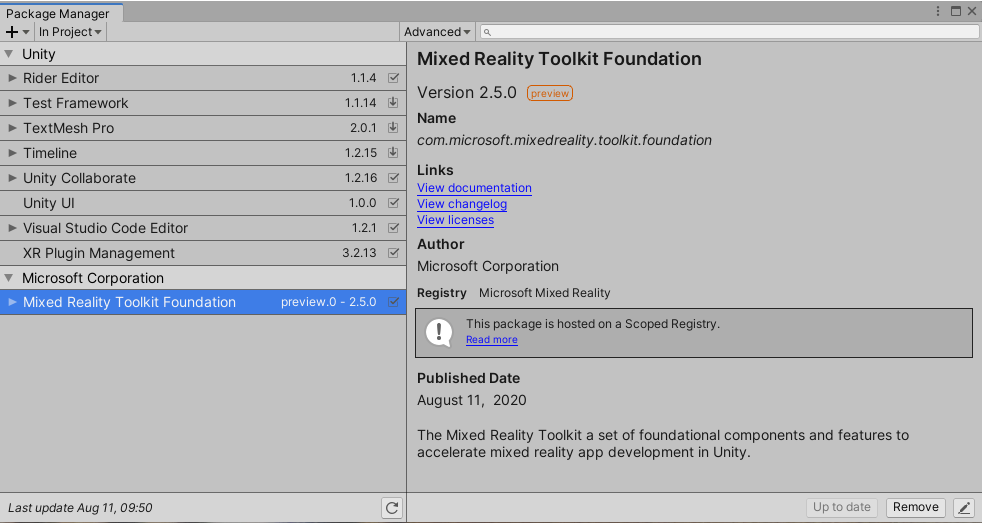Mixed Reality Toolkit and Unity Package Manager
Starting with version 2.5.0, the Microsoft Mixed Reality Toolkit is available using the Unity Package Manager (UPM), on Unity 2019.4 and newer.
Installing Mixed Reality features using the Unity Package Manager
The Unity Package Manager uses a manifest file (manifest.json) to determine which packages to install and the registries (servers) from which they can be installed.
Note
As of version 2.5.0 of the MRTK, initial registration of the server and packages is a per-project, manual procedure, please read the following sections for detailed instructions.
This process is required due to UPM's use of legacy npm search functionality (/-/all) that is not supported by Azure DevOps.
Registering the Mixed Reality component server
For each project that will be using the Microsoft Mixed Reality Toolkit, the manifest.json file (in the Packages folder) will need to have the Mixed Reality scoped registry added. The following illustrate how to properly modify manifest.json to support Mixed Reality.
- Open
<projectRoot>/Packages/manifest.jsonin a text editor, such as Visual Studio Code. - At the top of the manifest file, add the Mixed Reality server to the scoped registry section and save the file.
{
"scopedRegistries": [
{
"name": "Microsoft Mixed Reality",
"url": "https://pkgs.dev.azure.com/aipmr/MixedReality-Unity-Packages/_packaging/Unity-packages/npm/registry/",
"scopes": [
"com.microsoft.mixedreality",
"com.microsoft.spatialaudio"
]
}
],
Adding MRTK packages
Once the Microsoft Mixed Reality scoped registry has been added to the manifest, the MRTK packages can be specified.
The Unity Package Manager section of the Mixed Reality Toolkit package article describes the available MRTK packages, their contents and the scenarios for their use.
To add an MRTK package, modify the dependencies section of the Packages/manifest.json file. The following example illustrates adding the foundation, tools and examples packages, the standard assets package will be added automatically as a dependency of the foundation.
"dependencies": {
"com.microsoft.mixedreality.toolkit.foundation": "2.5.0",
"com.microsoft.mixedreality.toolkit.tools": "2.5.0",
"com.microsoft.mixedreality.toolkit.examples": "2.5.0",
Managing Mixed Reality features with the Unity Package Manager
Once a Mixed Reality Toolkit package has been added to the package manifest, it can be managed using the Unity Package Manager user interface.

Note
If a Mixed Reality Toolkit package is removed using the Unity Package Manager, it will have to be re-added using the previously described steps.
Using Mixed Reality Toolkit examples
Unlike when using asset package (.unitypackage) files, com.microsoft.mixedreality.toolkit.examples and com.microsoft.mixedreality.toolkit.handphysicsservice do not automatically import the example scenes and assets.
To utilize one or more of the examples, please use the following steps:
- In the Unity Editor, navigate to
Window>Package Manager - In the list of packages, select
Mixed Reality Toolkit Examples - Locate the desired sample(s) in the
Sampleslist - Click
Import into Project

When an example package is updated, Unity provides the option to update imported samples.
Note
Updating an imported sample will overwrite any changes that have been made to that sample and the associated assets.